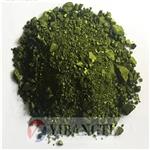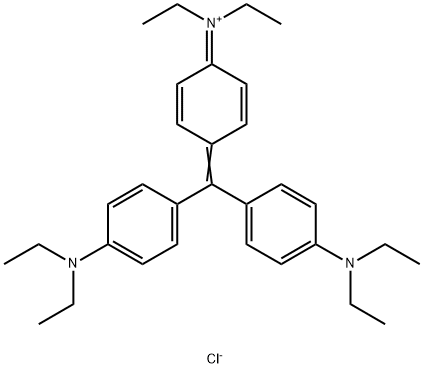- ETHYL VIOLET
-

- $0.00 / 1kg
-
2023-06-16
- CAS:2390-59-2
- Min. Order: 1kg
- Purity: 99%
- Supply Ability: 500000kg
- ETHYL VIOLET
-

- $1.00 / 100g
-
2019-12-23
- CAS:2390-59-2
- Min. Order: 100EA
- Purity: 98%min
- Supply Ability: G/KG/T
|
| | ETHYL VIOLET Basic information |
| Product Name: | ETHYL VIOLET | | Synonyms: | basicviolet;Ethanaminium,N-(4-(bis[4-(diethylamino)phenyl]methylene)-2,5-cyclohexadien-1-ylidene)-N-ethyl-,chloride;[Sensitive spectrophotoMetric reagent for anionic surfactants];Ethyl Violet ;Tris(p-(dieth- Aylamino)-phenyl)methylium Chloride;Ethyl crystal violet;Lowacryl Violet 4;Shikiso Acid Brilliant Blue 6B | | CAS: | 2390-59-2 | | MF: | C31H42ClN3 | | MW: | 492.15 | | EINECS: | 219-231-5 | | Product Categories: | Triphenylmethane;Organics;Analytical Chemistry;Ion Association | | Mol File: | 2390-59-2.mol |  |
| | ETHYL VIOLET Chemical Properties |
| Melting point | >250°C | | Boiling point | 631.13°C (rough estimate) | | density | 0.9659 (rough estimate) | | refractive index | 1.6010 (estimate) | | storage temp. | Inert atmosphere,Room Temperature | | solubility | H2O: 10 mg/mL, very deep purple | | form | powder | | Colour Index | 42600 | | color | Olive green | | PH Range | Yellow (0.0) to blue (3.5) | | Odor | Odorless | | Water Solubility | Soluble in water (10 mg/ml). | | λmax | 596nm | | ε(extinction coefficient) | ≥12000 at 250-256nm in water at 0.003mg/mL
≥17000 at 304-310nm in water at 0.003mg/mL | | BRN | 4117566 | | Stability: | Light Sensitive | | Major Application | Integrated circuits, fiber-optic pH sensors, display device, inks, high-lighter, lithographic printing plates, decoder system, detergents, hair dyes, cosmetics, wound dressing materials, diagnosis of diseases caused by elemental imbalances, antimicrobial, photochemotherapeutic agent | | EPA Substance Registry System | C.I. Basic Violet 4 (2390-59-2) |
| Safety Statements | 24/25 | | WGK Germany | 3 | | RTECS | KH2682000 | | TSCA | Yes | | HS Code | 32041300 | | Toxicity | mouse,LDLo,oral,320mg/kg (320mg/kg),Archives of Environmental Contamination and Toxicology. Vol. 14, Pg. 111, 1985. |
| | ETHYL VIOLET Usage And Synthesis |
| Chemical Properties | green to olive-green crystalline powder | | Uses | Ethyl violet has been used to stain pancreatic tissue and elastin in the detection of gram negative bacteria, and as a reagent for the extractive-spectrophotometric determination of anionic surfactants. It has been used in the extraction and spectrophotometric determination of copper. Along with the anionic dye zincon, ethyl violet is used in counterion dye of proteins in SDS-polyacrylamide gel electrophoresis. Along with the anionic dye zincon, ethyl violet is used in counterion dye of proteins in SDS-polyacrylamide gel electrophoresis. | | Definition | ChEBI: An organic chloride salt that is the monochloride salt of ethyl violet cation. Used for inclusion in mixed dye solutions of the iron resorcin fuchsin type for demonstrating elastic fibres. | | Biological Activity | Ethyl violet is a cationic triarylmethane dye th at is the ethyl homolog of crystal violet. It is a general histological and pathological stain. Ethyl violet has been used to stain pancreatic tissue and elastin, in the detection of gram negative bacteria, and as a reagent for the extractive-spectrophotometric determination of anionic surfactants. Ethyl violet induces mitochondrial permeability. It has been used in the extraction and spectrophotometric determination of copper. Along with the anionic dye zincon, ethyl violet is used in counterion dye of proteins in SDS-polyacrylamide gel electrophoresis. | | Properties and Applications |
|
TEST ITEMS
|
SPECIFICATION
|
|
APPEARANCE
|
BLACK
VIOLET
|
|
LIGHTING
|
2-3
|
|
SOAPING
|
3-4
|
|
PERSPIRATING
|
4
|
|
FRICTION(DRY)
|
4
|
|
FRICTION(WET)
|
3
|
|
RESIDUE ON 80 MESH
|
5.0% max
|
|
WATER SOLUBLE
|
1.0% max
|
|
VOLATITE 105 °C
|
1.0% max
|
|
TINTING STRENGTH
|
100-105 %
|
|
WEIGHT METAL TOTAL
|
50ppm max
|
|
| | ETHYL VIOLET Preparation Products And Raw materials |
|